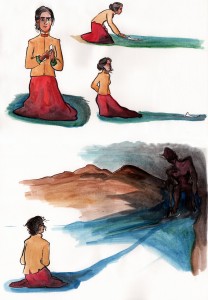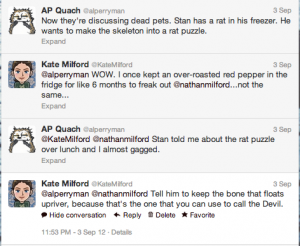Greenglass House deadline: T-13 days. The good news: I’m really close to done. The bad news (earmuffs, Lynne Polvino): some of what I have left, I simply haven’t figured out yet.
Except that this isn’t exactly bad news. Not to me, anyway. For me, part of the joy of finishing a book is seeing all the pieces come together, in much the same way that it’s part of the joy of reading. Part of the reason I like writing by the proverbial seat of my pants is that when I start out with a certain percentage (say, 50%) of the pieces in hand, I like the way the rest of the pieces find me. Or re-find me, by twisty turny means. Last week this happened to me not once, but twice. Since one of those happenings also included a friend and a very cool piece of art, I’m going to tell you about that one.
Exhibit Number One, because it’s the coolest exhibit:
The caption is the text of the email that accompanied the image. But let me back up.
Ashley Quach is an artist, screenwriter, and Twitter-turned-In-Real-Life friend who was first introduced to me when my husband, Nathan, found her blog post entitled A Tender Ode to Bloodsport. We also became crowdfunding buddies in a sense; my Kickstarter campaign for The Kairos Mechanism concluded just as her Indiegogo campaign to finance the short film Appleseeds began. (The first screening of the rough cut happens this month, by the way, and if you’re planning to be in Berkeley, CA, on October 14th, you should definitely consider attending the party.)
But to return to how pieces come together, here’s Exhibit Number Two:
Now, if you’ve read The Boneshaker, you might remember a moment during the past of Dr. Jasper Bellinspire in which a woman hands him a small bone and tells him it’s the one that floated upriver. This is a piece of lore I came across somewhere: if you take a black cat, reduce it to bones, and set them in a moving river, one bone will float against the current. That one can be used to summon the Devil. So it’s something I already knew, something I had made use of. Maybe because of that, it lived in a different part of my head than the part that needed to find the remaining story pieces for Greenglass House. Until, that is, Ashley sent me her “doodle.”
Who knows why we compartmentalize the way we do? I can make a guess about myself in this case: Greenglass House isn’t about devil folklore the way The Boneshaker and The Broken Lands are–which is to say, it isn’t about devil folklore at all. But it is about folklore; specifically, the folklore of Nagspeake, which, fortunately, has an elasticity that allows me to manipulate it basically however I want. And I realized when I saw Ashley’s message sent picture I realized that Nagspeake needed this bit of lore. And not because it is devil lore or summoning lore, but because it is orphan lore, which my adopted protagonist Milo, who is deeply concerned about his heritage and identity, would be very interested in. Greenglass House isn’t a chosen one story. It is, in fact, an anti-chosen one story, if anything. Still, this piece, the story I wrote after receiving message sent is a critical part of Milo’s adventure.
Very little of this story will actually appear in Greenglass House–Milo encounters it in a book of Nagspeake folklore he’s reading, The Raconteur’s Common-Place Book. But because the grand plan is to release The Raconteur’s Common-Place Book as Volume 3 of The Arcana Project, I wrote the story. Here’s a bit of the first draft (a “doodle,” if you will), with thanks to Ashley Quach for giving me one of the missing pieces I was looking for.
From The Summons of the Bone
It took her a few days to find a black cat, another few after that to find enough wood to boil water. When all that was left of the cat were its bones, she made her way to the river’s edge and set the bones on the water. The frothing river took all but one. That one spun gently as if it were caught in the mildest of eddies. Then it slid against the plunging flow, upriver and out of sight.
A moment later, the dark figure of a tall man appeared at the bend in the Skidwrack around which the single bone had disappeared. He strode upon the surface as if it were a road, with a long overcoat wrapped around him and a grey fedora keeping the rain from his head.
Nell watched with her heart in her throat as he approached until the strange figure stood before her with his coat whipping about his ankles and rain dripping from his hat. “I received your message,” he said in a voice like thunder rolling far, far away. She couldn’t see his face, but she sensed that, in the shadows under the brim of the hat, a pair of searching eyes was considering her curiously. “Put forth your question.”
She folded her shaking hands and cleared her throat, and she saw the dark man smile very slightly, as if there was something endearing about her fear. “I want you to stop the water rising.”
The man put his hands into the pockets of his coat. “That isn’t a question.”
“Please stop the water rising?”
“That is still not a question. It’s a request with a question mark at the end of it.”
“Well—can you stop the water rising?”
He smiled more. “You called me all this way to ask me a question I can answer with a single word?”
The girl realized her mistake and raised her hands quickly. “Wait. No. Let me think.” And as she thought about her question, she realized she had a problem. She had expected to be allowed to make a request, but what the dark man had offered was something different. She could perhaps ask, will you stop the water rising—but even if he answered yes, that didn’t mean he would stop it now, or at any time before her city would be wiped off the coast. She could not think of any way to ask him to solve the problem of the rising water.
At last she asked the only question she’d come up with. It didn’t accomplish what she’d wanted to accomplish from this meeting, but it was the best she could think of to do. “How can I stop the water rising?”
“Ah. Now that is a good question…

